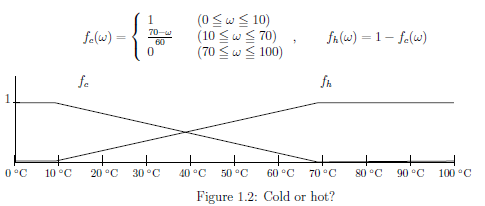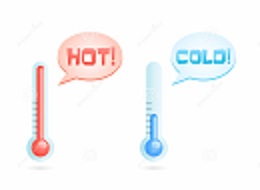 Axioms 1 and 2 (mentioned in the previous section ) are too abstract to use quantum language in real situations. So, let me show
a simple example.
What you will see in the following chapters is
Axioms 1 and 2 (mentioned in the previous section ) are too abstract to use quantum language in real situations. So, let me show
a simple example.
What you will see in the following chapters is
$\bullet$ to fill the gap between Axiom 1 and the following simple example (i.e., "Cold" or "Hot").
[The measurement of "Cold or Hot" for the water in a cup]
(The following can be read without the knowledge of quantum language)

Therefore, for example,
| $(A_1)$: | You choose one person from the testees, and you ask him/her whether the water (with 55℃) is "cold" or "hot" ?. Then the probability that he/she says$ \left[\begin{array}{ll} {} \mbox{"cold"} \\ {} \mbox{"hot"} \end{array}\right] $ is given by $ \left[\begin{array}{ll} {}f_{\text c}(55)=0.25 \\ {} f_{\text h}(55)=0.75 \end{array}\right] $ |
and measured value space $X=\{c, h\}$
Here, consider the "[C-H]-thermometer" such that

| $(A_2)$: | for water with $\left.\begin{array}{ll}\omega \\ {}\end{array}\right.$℃ , [C-H]-thermometer presents$ \left[\begin{array}{ll} {} \mbox{c} \\ {} \mbox{h} \end{array}\right] $with probability$ \left[\begin{array}{ll} {} f_{\text c}(\omega) \\ {} f_{\text h}(\omega) \end{array}\right] $. This [C-H]-thermometer is denoted by ${\mathsf O} =$ $(f_{c},f_{h})$ |
| $(A_3)$: | $\qquad$(A$_1$)$\Longleftrightarrow$(A$_2$) |
| $(A_4)$: | When an observer takes a measurement by [C-H]-insrument(= measuring instrument ${\mathsf O} =(f_{\text c},f_{\text h})$) for water (= System (measuring object)) with 55℃ (state $(=\omega =55 \in \Omega) )$, the probability that measured value $ \left[\begin{array}{ll} \mbox{c} \\ \mbox{h} \end{array}\right]$ is obtained is given by $\left[\begin{array}{ll} f_{\mbox{c}}(55)=0.25 \\ f_{\mbox{h}}(55)=0.75 \end{array}\right]$ |
That is, we get the following translation $$ (A_1) \xrightarrow[\mbox{translation}]{} (A_4) $$
 You may think that
You may think that
However, our purpose in this book is
The above example will be again discussed in the following chapter(Example 2.31).
